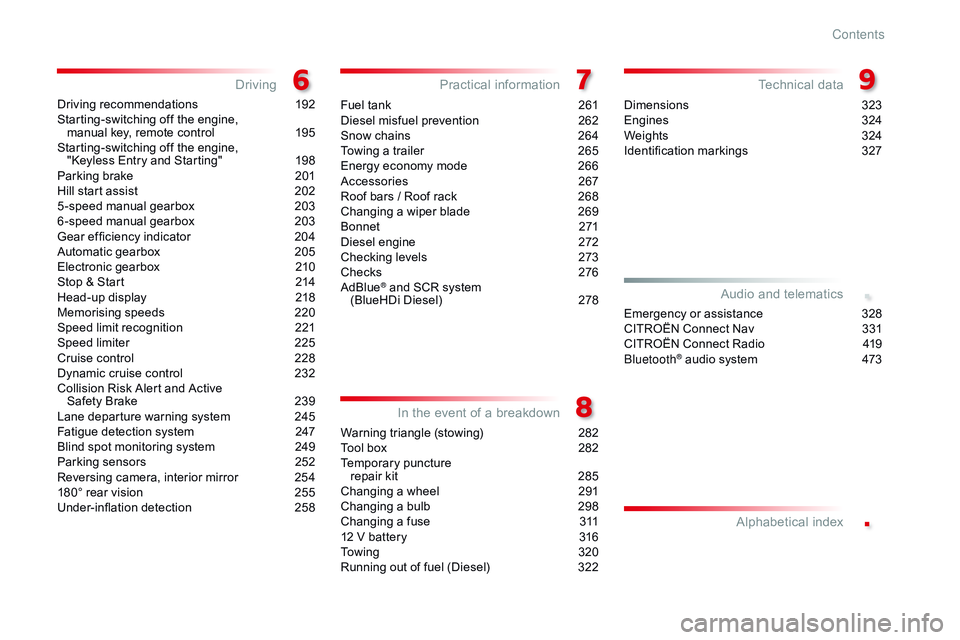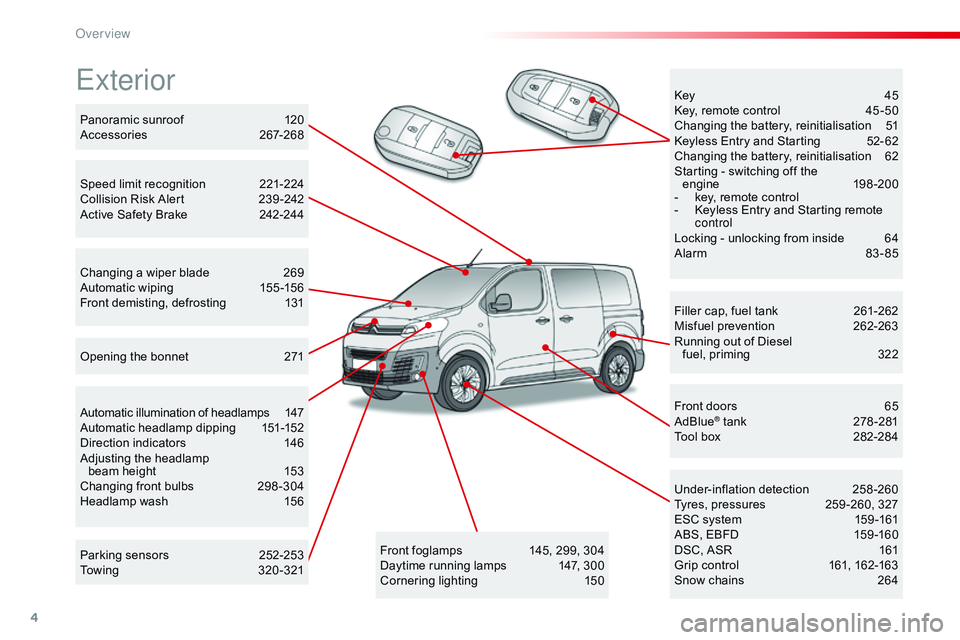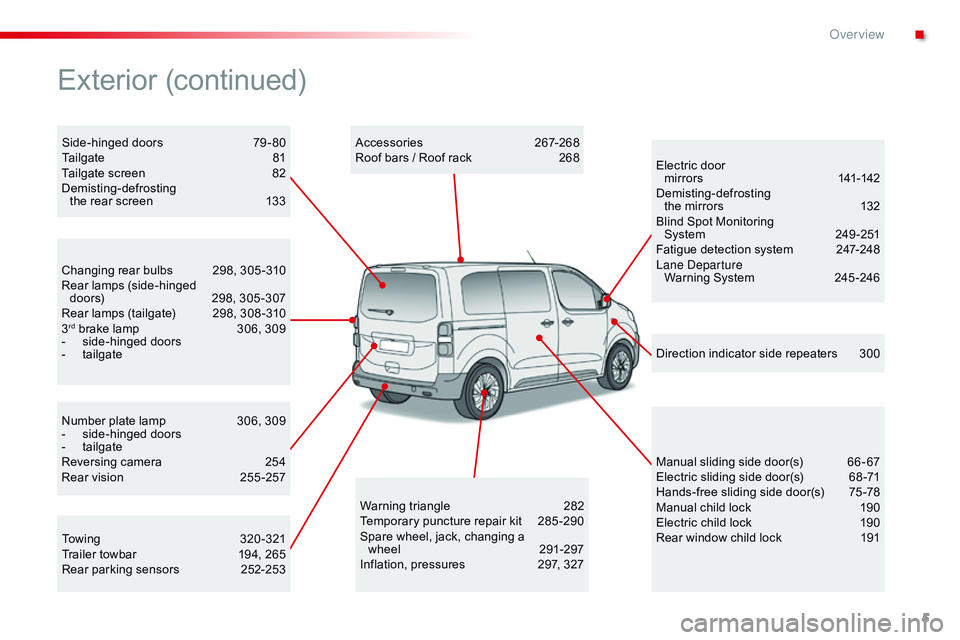towing CITROEN DISPATCH SPACETOURER 2017 Handbook (in English)
[x] Cancel search | Manufacturer: CITROEN, Model Year: 2017, Model line: DISPATCH SPACETOURER, Model: CITROEN DISPATCH SPACETOURER 2017Pages: 774, PDF Size: 48.25 MB
Page 5 of 774

.
.
Driving recommendations 192
Starting-switching off the engine, manual key, remote control
1
95
Starting-switching off the engine, "Keyless Entry and Starting"
1
98
Parking brake
2
01
Hill start assist
2
02
5 -speed manual gearbox
2
03
6 -speed manual gearbox
2
03
Gear ef ficiency indicator
2
04
Automatic gearbox
2
05
Electronic gearbox
2
10
Stop & Start
2
14
Head-up display
2
18
Memorising speeds
2
20
Speed limit recognition
2
21
Speed limiter
2
25
Cruise control
2
28
Dynamic cruise control
2
32
Collision Risk Alert and Active Safety Brake
2
39
Lane departure warning system
2
45
Fatigue detection system
2
47
Blind spot monitoring system
2
49
Parking sensors
2
52
Reversing camera, interior mirror
2
54
180° rear vision
2
55
Under-inflation detection
2
58Fuel tank
2 61
Diesel misfuel prevention
2 62
Snow chains
2
64
Towing a trailer
2
65
Energy economy mode
2
66
Accessories
2
67
Roof bars / Roof rack
2
68
Changing a wiper blade
2
69
B o nnet
2
71
Diesel engine
2
72
Checking levels
2
73
Checks
2
76
AdBlue
® and SCR system
(BlueHDi Diesel) 2 78
Warning triangle (stowing)
2
82
Tool box
2
82
Temporary puncture
repair kit
2
85
Changing a wheel
2
91
Changing a bulb
2
98
Changing a fuse
3
11
12 V battery
3
16
To w i n g
3
2 0
Running out of fuel (Diesel)
3
22Dimensions
3
23
Engines
3
24
Weights
3
24
Identification markings
3
27
Driving
Practical information
In the event of a breakdown Technical data
Emergency or assistance 3
28
CITROËN Connect Nav 3 31
CITROËN Connect Radio
4
19
Bluetooth
® audio system 4 73
Audio and telematics
Alphabetical index
Contents
Page 6 of 774

4
Exterior
Filler cap, fuel tank 261-262
Misfuel prevention 26 2-263
Running out of Diesel fuel, priming
3
22
Under-inflation detection
2
58-260
Tyres, pressures
2
59 -260, 327
ESC system
1
59 -161
ABS, EBFD
1
59 -160
DSC, ASR
1
61
Grip control
1
61, 162-163
Snow chains
2
64
Front doors
6
5
AdBlue
® tank 2 78 -281
Tool box 2 82-284
Automatic illumination of headlamps
1
47
Automatic headlamp dipping
1
51-152
Direction indicators
1
46
Adjusting the headlamp beam height
1
53
Changing front bulbs
2
98 -304
Headlamp wash
1
56
Panoramic sunroof
1
20
Accessories
26
7-268
Opening the bonnet
2
71 Key
4
5
Key, remote control
4
5 -50
Changing the battery, reinitialisation
5
1
Keyless Entry and Starting
5
2- 62
Changing the battery, reinitialisation
6
2
Starting - switching off the engine
1
98-200
-
k
ey, remote control
-
K
eyless Entry and Starting remote
control
Locking - unlocking from inside
6
4
Alarm
8
3-85
Speed limit recognition
2
21-224
Collision Risk Alert
2
39 -242
Active Safety Brake
2
42-244
Changing a wiper blade
2
69
Automatic wiping
1
55 -156
Front demisting, defrosting
1
31
Front foglamps
1
45, 299, 304
Daytime running lamps
1
47, 300
Cornering lighting
1
50
Parking sensors
2
52-253
Towing
32
0-321
Over view
Page 7 of 774

5
Number plate lamp 306, 309
- s ide-hinged doors
-
t
ailgate
Reversing camera
2
54
Rear vision
2
55 -257
Changing rear bulbs
2
98, 305 -310
Rear lamps (side-hinged doors)
2
98, 305 -307
Rear lamps (tailgate)
2
98, 308 -310
3
rd brake lamp 3 06, 309
-
s ide-hinged doors
-
t
ailgate
Warning triangle
2
82
Temporary puncture repair kit
2
85 -290
Spare wheel, jack, changing a wheel
29
1-297
Inflation, pressures
2
97, 327Electric door
mir ror s
14
1-142
Demisting-defrosting
the mirrors
1
32
Blind Spot Monitoring System
2
49-251
Fatigue detection system
2
47-248
Lane Departure Warning System
2
45 -246
Direction indicator side repeaters
3
00
Manual sliding side door(s)
6
6 - 67
Electric sliding side door(s)
6
8 -71
Hands-free sliding side door(s)
7
5 -78
Manual child lock
1
90
Electric child lock
1
90
Rear window child lock
1
91
Accessories
26
7-268
Roof bars / Roof rack
2
68
Towing
32
0-321
Trailer towbar
1
94, 265
Rear parking sensors
2
52-253
Side-hinged doors
7
9 - 80
Tailgate
8
1
Tailgate screen
8
2
Demisting-defrosting
the rear screen
1
33
Exterior (continued)
.
Over view
Page 118 of 774

116
Stowing rings
Use the stowing rings on the rear floor to fix the
net, your loads or luggage.
High load retaining net
This allows the use of the entire load space, up
to the roof:
-
b
ehind the front seats in row 1, when the
rear seats (and bench seats) in rows 2 and
3 are folded or removed.
-
b
ehind the rear seats and bench seats
in row 2, when the rear seats (and bench
seats) in row 3 are folded or removed.
Luggage retaining net
Attached to the stowing rings on the rear floor,
it allows objects to be held down.
As a safety measure in the event of
sudden braking, it is recommended that
heavy objects are placed as far for ward
in the vehicle as possible.
It is recommended that the load is
secured firmly using the stowing rings
on the floor. As a safety measure in the event of
sudden braking, it is recommended that
heavy objects are placed on the floor as
close as possible to the backrest of the
seat(s) or bench seat.
Ease of use and comfort
Page 119 of 774

117
Upper fixings
Lower fixings (behind row 1)
If your vehicle has fixed one-piece bench seats
or seats and bench seats: F
On each side in row 2, insert the fixings in the
floor anchorages then turn them a quarter turn
to lock them in place (as shown above).
Place them as close as possible to the end of
the rail.
F
U
nclip the anchorage cover in the roof on
each side.
F
O
n each side in row 2, insert the fixings in
the floor anchorages (as shown above). If your vehicle has seats and bench seats or
individual seats on rails
:
Lower fixings (behind row 2)
F Use the stowing rings.
Fit the net
Unclip the upper fixing covers and secure the
lower fixings (as previously described).
F
F
old (table position) the seats and bench
seats in rows 2 and 3 (according to
equipment).
F
U
nroll the high load retaining net.
F
P
osition the upper net fixings in the
corresponding anchorages in the roof
(first one side, then the other).
F
F
ully extend the straps.
F
O
n each side, attach the bottom fixings of
the net to the lower anchorages (behind
row 1) or in the stowing rings (behind
row
2).
F
P
ull on the straps to stretch the net.
F
C
heck that the net is attached securely and
properly extended.
Never use the ISOFIX ring intended
for fixing the upper strap of a child seat
with Top Tether.
3
Ease of use and comfort
Page 124 of 774

122
Unfolding
F Pull each table top fully up then pivot them on each side into the horizontal position. F
R
aise each table top, going beyond the
point of resistance, to the vertical position.
F
P
ush each table top down into its housing
until it clicks into place.
F
P
ush the control then tip the table
assembly downward until it clicks into
place.
Folding
Before stowing the table tops, check
that there is no object underneath.
Before tipping the assembly down,
check that the two table tops have
clicked home in the low position and
that there is nothing in the cup holder
area (such as a can or pen).
F
O
perate the control on the top and pull the
table assembly up until it clicks into place.
Cup holders
Liquids carried in an open vessel (a cup
or mug) could be spilt, presenting a risk.
Take care.
Never use the table in this position
while the vehicle is being driven.
Two cups or cans and small objects (such as
a credit card, portable ashtray or pen) can be
carried in the middle of the unfolded table.
Ease of use and comfort
Page 136 of 774

134
In order for these systems to be fully effective, follow the operation and maintenance
guidelines below:
F
T
o obtain an even air distribution, take care not to obstruct the exterior air intake grilles
located at the base of the windscreen, the nozzles, the vents and the air outlets, as well
as the air extractor located at the rear.
F
D
o not cover the sunshine sensor, located at the top of the windscreen; this is used for
regulation of the air conditioning system.
F
O
perate the air conditioning system for at least 5 to 10 minutes, once or twice a month
to keep it in per fect working order.
F
E
nsure that the passenger compartment filter is in good condition and have the filter
elements replaced regularly.
W
e recommend the use of a combined passenger compartment filter. Thanks to its
special active additive, it contributes to the purification of the air breathed by the
occupants and the cleanliness of the passenger compartment (reduction of allergic
symptoms, bad odours and greasy deposits).
F
T
o ensure correct operation of the air conditioning system, you are also advised to have
it checked regularly as recommended in the maintenance and warranty guide.
F
I
f the system does not produce cold air, switch it off and contact a CITROËN dealer or a
qualified workshop.
Recommendations for heating, ventilation and air conditioning
If after an extended stop in sunshine,
the interior temperature is very high, first
ventilate the passenger compartment for
a few moments.
Put the air flow control at a setting high
enough to quickly change the air in the
passenger compartment.
The air conditioning system does not
contain chlorine and does not present
any danger to the ozone layer.
The condensation created by the air
conditioning results in a discharge
of water under the vehicle which is
per fectly normal.
When towing the maximum load on a steep gradient in high temperatures, switching off the
air conditioning increases the available engine power and so improves the towing ability.
Stop & Start
The heating and air conditioning
systems only work when the engine is
running.
To maintain a comfortable temperature
in the passenger compartment, you can
temporarily deactivate the Stop & Start
system.
For more information on Stop & Star t ,
refer to the corresponding section.
Air vents
To close a vent, move the control
towards the outside of the vehicle. Slight
resistance may be felt.
Ease of use and comfort
Page 160 of 774

158
Automatic operation of
hazard warning lamps
Hazard warning lamps
When braking in an emergency, depending on
the rate of deceleration, as well as when the
ABS regulation is invoked or in the event of an
impact, the hazard warning lamps come on
automatically.
They switch off automatically the first time you
accelerate.
F
Y
ou can also switch them off by pressing
the button.
Visual warning with all of the direction
indicators flashing to alert other road users to a
vehicle breakdown, towing or accident.
Emergency or
assistance call
This system allows you to make an emergency
or assistance call to the emergency services or
to the dedicated CITROËN service.
For more information on Audio and
telematics and in particular the
use of this equipment, refer to the
corresponding section.
F
P
ress this button, all of the direction
indicators flash.
They can operate with the ignition off.
Safety
Page 196 of 774

194
When towing
Distribution of loads
F Distribute the load in the trailer so that the heaviest items are as close as possible to
the axle and the nose weight approaches
the maximum permitted without
exceeding
it.
Air density decreases with altitude, thus
reducing engine per formance. Above
1
000 metres, the maximum towed load must
be reduced by 10
% for every 1 000 metres of
altitude.
Side wind
F Take into account the increased sensitivity to side wind.
Cooling
Towing a trailer on a slope increases the
temperature of the coolant.
As the fan is electrically controlled, its cooling
capacity is not dependent on the engine speed.
F
T
o lower the engine speed, reduce your
speed.
The maximum towed load on a long incline
depends on the gradient and the ambient
temperature.
In all cases, keep a check on the coolant
temperature.
F
I
f the warning lamp and the
STOP warning lamp come on,
stop the vehicle and switch off
the engine as soon as possible.
Braking
Towing a trailer increases the braking distance.
To avoid overheating of the brakes, the use of
engine braking is recommended.
Ty r e s
F Check the tyre pressures of the towing vehicle and of the trailer, observing the
recommended pressures.
Lighting
F Check the electrical lighting and signalling on the trailer and the headlamp beam
height of your vehicle.
For more information on Weights
, refer
to the corresponding section.
The rear parking sensors will be
deactivated automatically to avoid the
audible signal if a genuine CITROËN
towbar is used.
If the ambient temperature is high, it
is recommended that the engine be
allowed to idle for 1 to 2 minutes after
the vehicle comes to a stop, to facilitate
its cooling. For more information on Adjusting the
headlamp beam height
, refer to the
corresponding section.
Driving
Page 233 of 774

231
Exceeding the programmed
speed
If the programmed speed is exceeded, the
displayed speed flashes.
Once the vehicle returns to the programmed
speed, the display becomes steady again.
Switching off
F Turn thumbwheel 1 to the "0" position. T
he display of information related to the
cruise control disappears. Flashing of the dashes indicates a fault with the
cruise control.
Have it checked by a CITROËN dealer or a
qualified workshop.
Operating faultWhen the cruise control is switched on,
be careful if you maintain the pressure
on one of the programmed speed
changing buttons: this may result in a
very rapid change in the speed of your
vehicle.
Do not use the cruise control on
slippery roads or in heavy traffic.
On a steep descent, the cruise control
will not be able to prevent the vehicle
from exceeding the programmed speed.
On steep climbs or when towing,
the programmed speed may not be
achieved or maintained.
The use of mats not approved by
CITROËN may inter fere with the
operation of the cruise control.
To avoid any risk of jamming of the
pedals:
-
e
nsure that the mat is secured
c o r r e c t l y,
-
n
ever fit one mat on top of another.
6
Driving